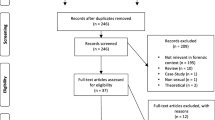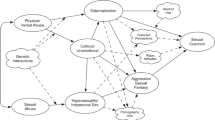Abstract
The sexual components of sadism are conceptualized within the contexts of different forms of sadism. In aggression-drive sadism, sexuality is seen as a generalization of instinctual reactivity. Parallels are presented of such spillover between aggression and anxiety and even between aggression and oral impulses, with the notion that any areas of excitation or partial impulses can be energized by the acute release of energy in another domain. Another dynamic is presented for re-enactment sadists, in which the sexuality has a relational meaning. In such cases, sexuality is intertwined with the aggression, as the sadistic ritual actually re-evokes an original trauma that features these elements. It is further agued that the sexuality in these two sadistic modes is not consistent. The instinctual spillover that occurs in hostile psychopathy is psychosexually rooted in phallic functioning, in which relational implications are absent, while the sexuality in re-enacted sadism is genitally based, and is intrinsically linked to an imagined emotional relationship with the victim that is intended to ameliorate and undo past trauma that haunt the perpetrator.
Similar content being viewed by others
References
Alexander, M. (2005). The killer next door. Reader's Digest, July, pp. 60–171.
American Psychiatric Association (2000). Diagnostic and statistical manual of mental disorders, Fourth Edition Text Revision (DSM-IV-R) Arlington, VA: American Psychiatric Association.
Bach, S. (1994). The language of perversion and the language of love. Northvale, NJ: Jason Aronson, Inc.
Berdichevsky, M.J. (1906). The red heifer. In A. Holtzman (Ed.) & W. Cutter (Trans.). Miriam and other stories (pp. 29–39). New Milford, CT: Toby Press, (Original work published in 2004).
Cleckley, H. (1941). The mask of sanity: An attempt to clarify some issues about the so-called psychopathic personality. St. Louis: Mosby.
de Sade, M. (1996). The 120 days of Sodom and other writings, A. Wainhouse and R. Seaver (Trans.). New York: Grove.
Fenichel, O. (1945). The psychoanalytic theory of neurosis. New York: Norton.
Freud, S. (1919). A child is being beaten. Standard Edition (Vol. 17, pp. 175–204). London, England: The Hogarth Press.
Freud, S. (1920). Beyond the pleasure principle. Part IV. Speculations on the death instinct. Standard Edition (Vol. 18, pp. 24–33). London, England: The Hogarth Press.
Griffing, S., Ragin, D., Morrison, S., Sage, R., Madry, L. & Primm, B. (2005). Reasons for returning to abusive relationships: Effects of prior victimization. Journal of Family Violence, 20, 341–348.
Gross, J. (2007). Aggression in hospitalized criminal offenders with mental illness and personality disorders: A psychoanalytic retrospective longitudinal study. Dissertation Abstracts International: Section B: The Sciences and Engineering, 68 (1-B), 621.
Groth, A.N., Burgess, W. & Holstrom, L.L. (1977). Rape: Power, anger, and sexuality. American Journal of Psychiatry, 134, 1239–1243.
Hare, R. (1991). The hare psychopathy checklist: Revised manual. Toronto, ON: Multi-Health Systems.
Henderson, D.R. (1939). Psychopathic states. London: Chapman & Hall.
Horney, K. (1932). The dread of women. International Journal of Psychoanalysis, 13, 348–360.
Jones, E. (1933). The phallic phase. International Journal of Psychoanalysis, 14, 1–34.
Juni, S. (2008). Conceptualization of hostile psychopathy and sadism. International Forum of Psychoanalysis, 17, 1–12.
Juni, S. & Cohen, P. (1985). Partial impulse erogeneity as a function of fixation and object relations. Journal of Sex Research, 21, 275–291.
Meloy, J.R. (1988). The psychopathic mind: Origins, dynamics, and treatment. Northvale, NJ: Aronson.
Meloy, J.R. (1995). Antisocial personality disorder. In G.O. Gabbard (Ed.), Treatments of psychiatric disorders (Vol. 2, pp. 2273–2290). Washington, DC: American Psychiatric Press.
Olmsted, M., Crowell, J. & Waters, E. (2003). Assortative mating among adult children of alcoholics and alcoholics. Family Relations: Interdisciplinary Journal of Applied Family Studies, 52, 64–71.
PDM Task Force (2006). Psychodynamic diagnostic manual. Silver Spring, MD: Alliance of Psychoanalytic Organizations.
Acknowledgements
The author is grateful to Dr. Julie Gross for her invaluable help in contextualizing active psychopathy within the framework of object relations theory. Her seminal work on sex offenders (Gross, 2007) served as a source for the object relations conceptualization of sadism in this paper.
Author information
Authors and Affiliations
Corresponding author
Rights and permissions
About this article
Cite this article
Juni, S. The Role of Sexuality in Sadism: Object Relations and Drive Theory Perspectives. Am J Psychoanal 69, 314–329 (2009). https://doi.org/10.1057/ajp.2009.17
Published:
Issue Date:
DOI: https://doi.org/10.1057/ajp.2009.17




